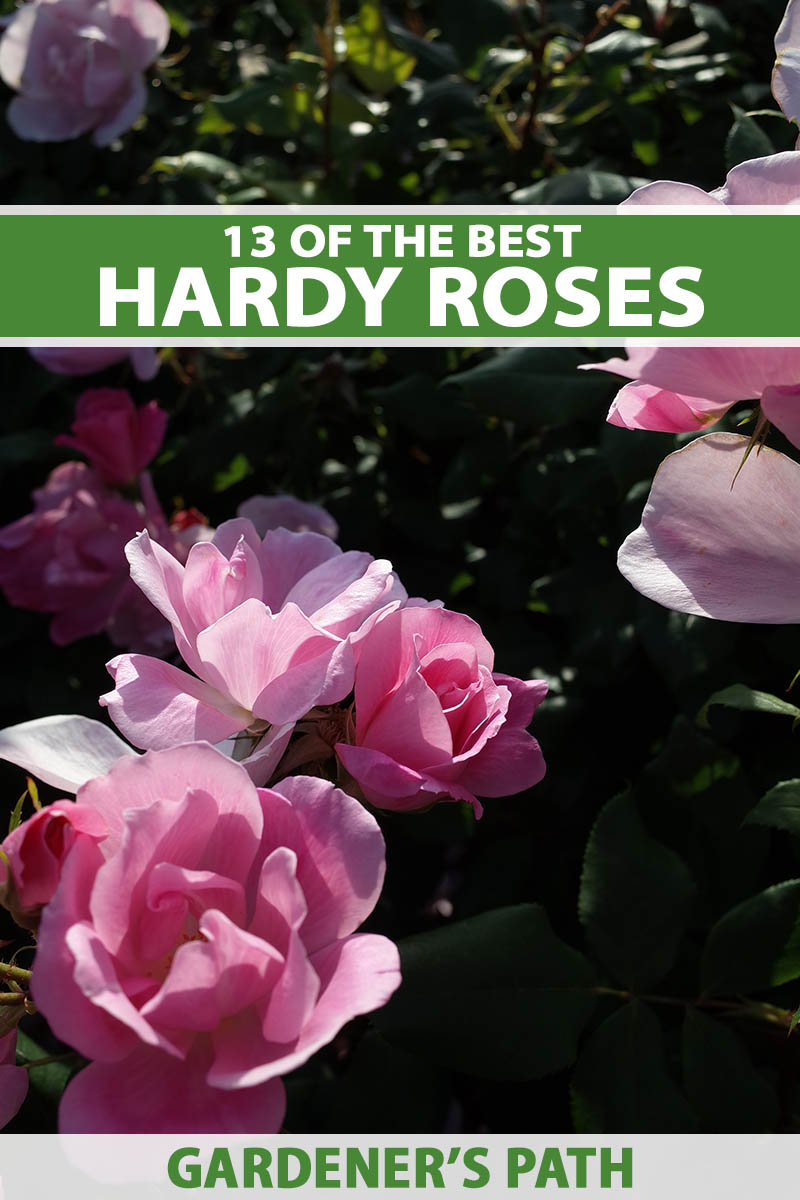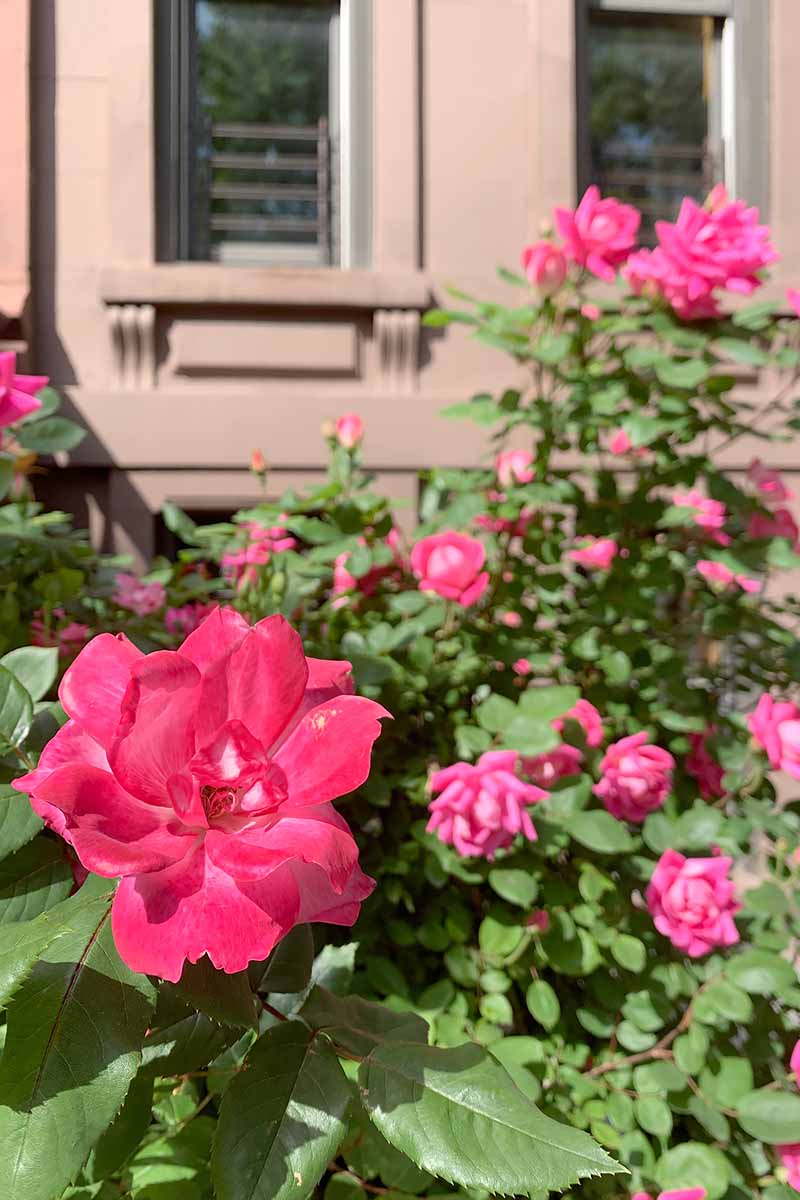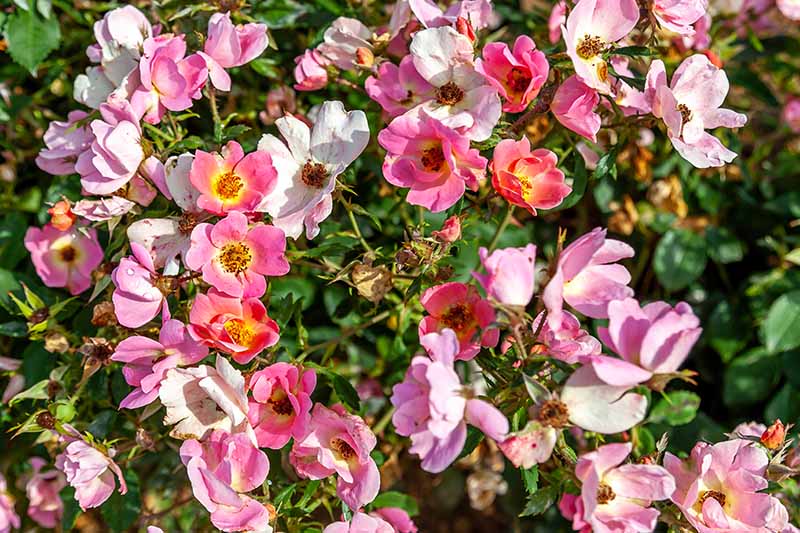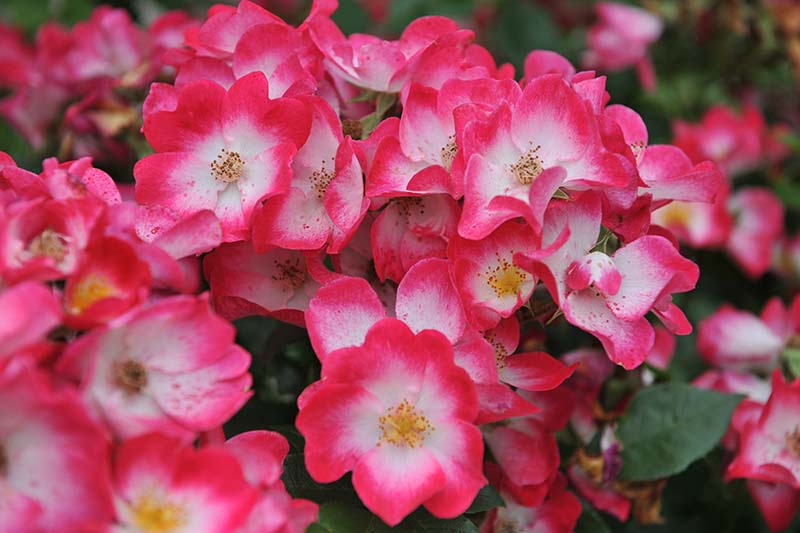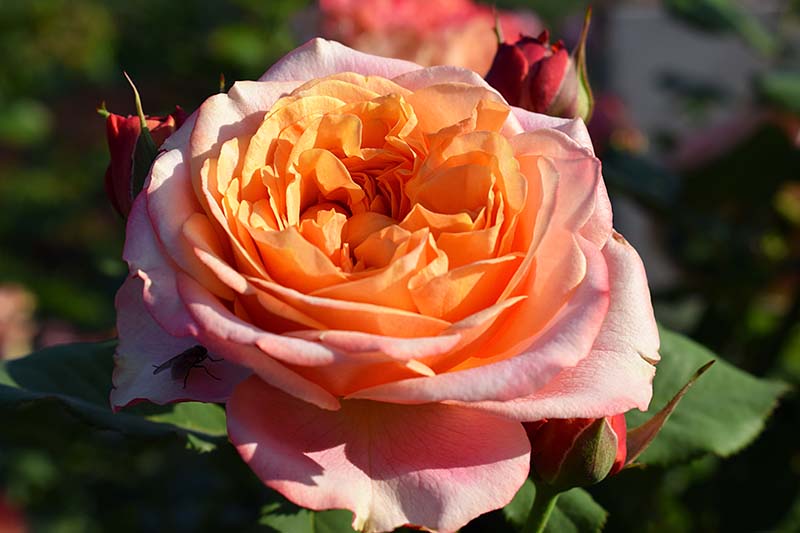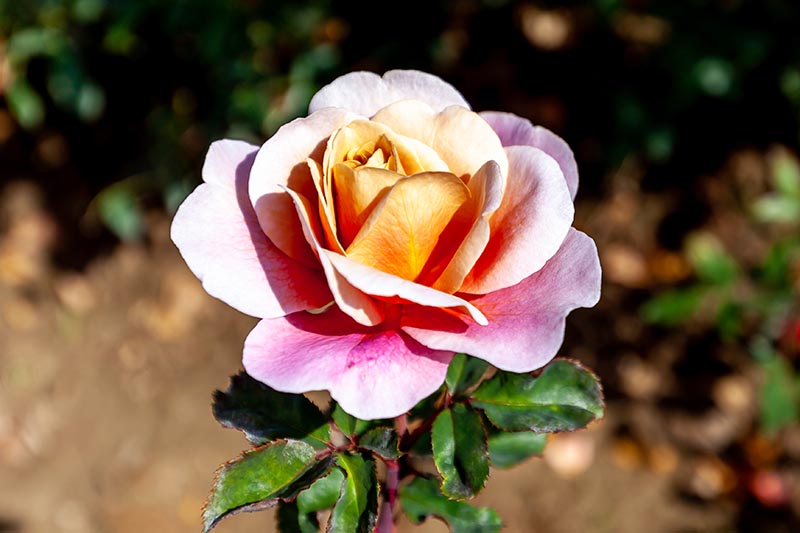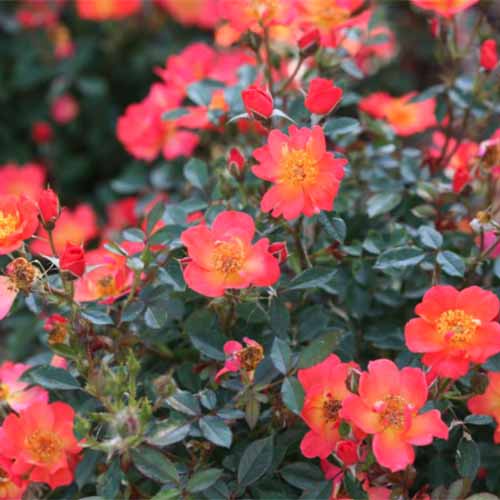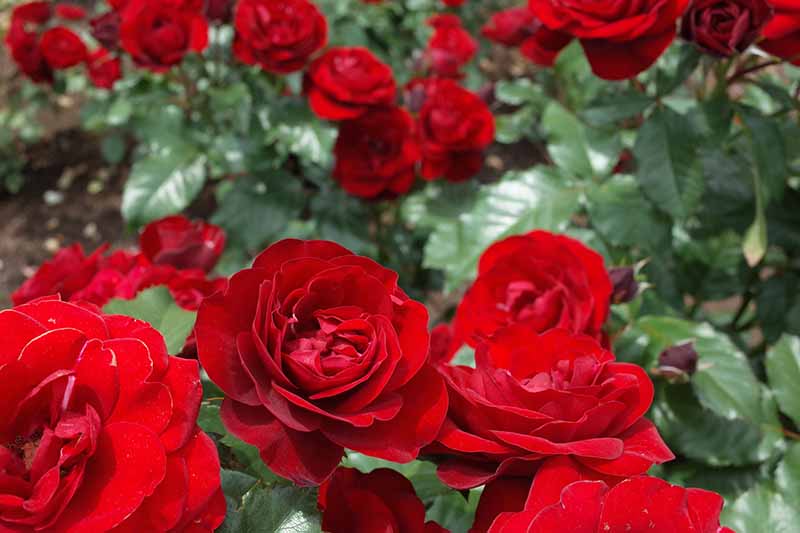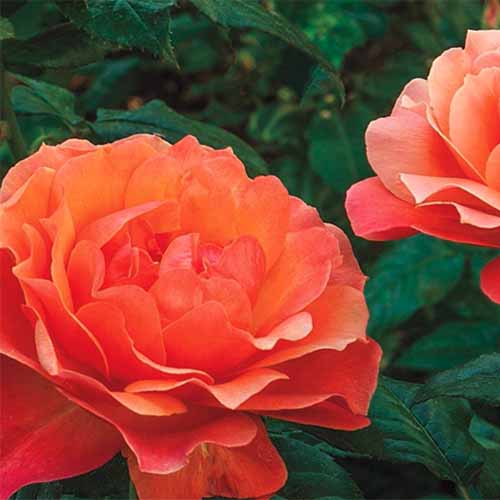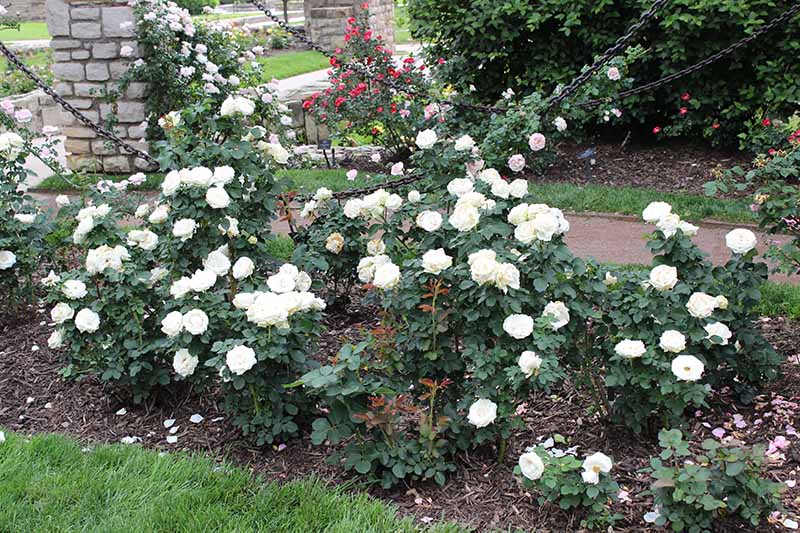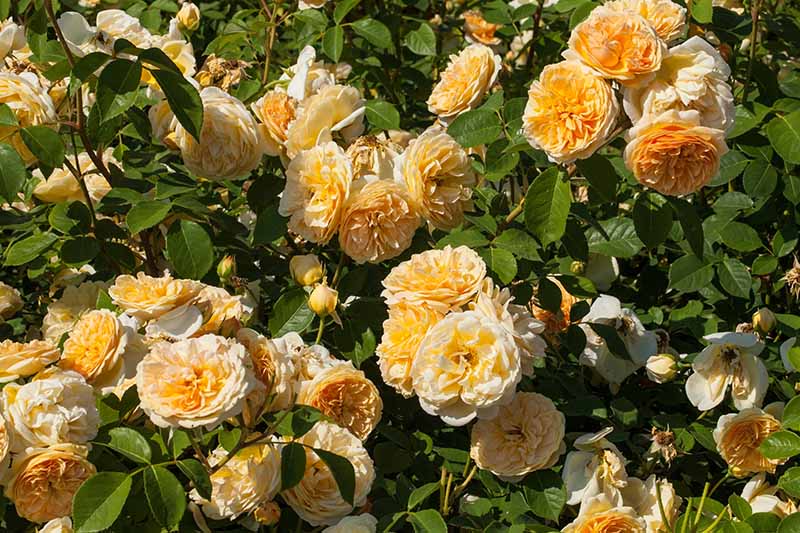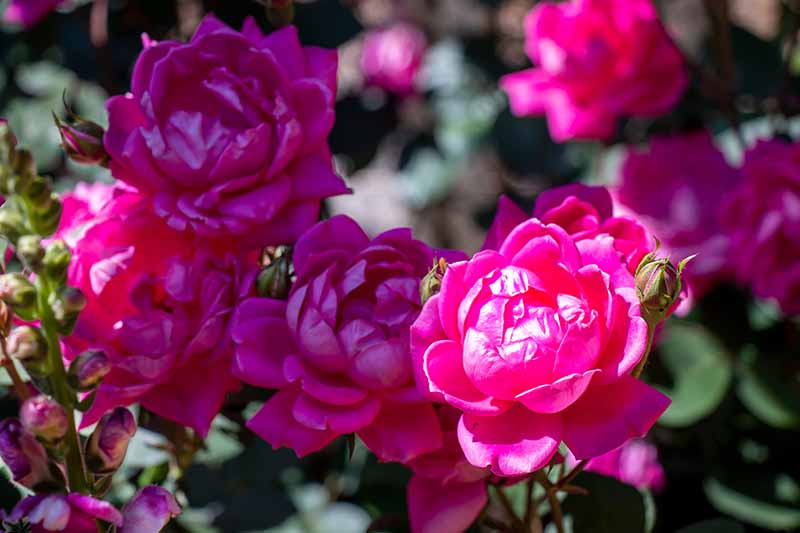My answer is that it doesn’t have to be difficult (though it can be). There are two key elements to making your life easier while still enjoying beautiful blossoms. The first way to ensure that you won’t be laboring in the garden all day long is by selecting the right plant for your space. We have a guide to help you with that part. We link to vendors to help you find relevant products. If you buy from one of our links, we may earn a commission. That’s why, these days, there are lots of options out there that are nothing like your grandma’s roses. If you plant a delicate hybrid tea, be prepared for some pampering. But a sturdy Knock Out can practically be planted and forgotten. Up ahead, we’ll cover a selection of several of the best hardy rose varieties out there. Before we dive in, if you want more information on the different rose classifications, we have a great primer to introduce you to the differences between a floribunda, species, or hybrid tea. Without further ado, it’s time to give hardy roses a closer look. Let’s go!
What to Look for in a Hardy Rose
When I help someone troubleshoot their rose woes, the most serious problems usually stem from the fact that the person unknowingly selected a plant that isn’t right for their area. Before you pick a plant, you need to take note of a few things if you want one that can survive well in your garden. The first consideration is your climate. Those in USDA Hardiness Zones 3 to 5 have a smaller range of roses to pick from. Don’t even try growing one that does best in Zones 6 and above if you live in Zone 5. You’ll be in for a constant fight. The same goes for light needs. Some roses can grow in partially shady conditions, but if you pick one that needs full sun for your sheltered spot, you can bet you’ll run into problems. Next, look for types that are resistant to diseases that you frequently encounter in your area. If you struggle with powdery mildew every year, for example, look at the plant tag and make sure your potential pick is resistant to powdery mildew. You might also want to think about how much effort you want to put into maintenance. Does the thought of deadheading in the heat of a summer afternoon sound like a nice escape from reality for a bit? Or is that just me? Okay, then, does it sound like torture? If you don’t want to deadhead, pick a self-cleaning type. Also, get to know the name Griffith Buck. He was a professor of horticulture at Iowa State University for decades. During his career, he made it his mission to breed hardy roses that could resist pests and diseases and survive in a range of climates. If you see his name on a container, or a plant called a “Buck rose,” it’s likely one tough bush. Other brands to look for are Knock Out, Oso Easy, and Kordes. All are working to breed tougher options. On top of that, keep in mind that wild or species roses are almost always going to be tougher than any of the highly cultivated and hybridized types out there. Tea roses in particular are quite fussy, and tend to succumb to pests and diseases. With all that in mind, we’ve done the legwork and found some of the best hard-to-kill options out there. Let’s take a look! A quick note on terms used in the following descriptions: single blossoms are flowers that have four to eight petals, usually in one row. Semi-doubles have around nine to 16 petals with more than one row. Double blooms have over 16 petals, and some in this category have petals numbering in the hundreds on each flower.
1. Bukavu
‘Bukavu’ is a hybrid musk, which is a grouping known for being more pest and disease resistant than others. This hybrid is particularly resistant, plus it’s awfully pretty. It has an arching growth habit and in the summer the plant is absolutely covered in blossoms. Sometimes you can’t even see the foliage underneath. The flowers themselves are carmine red on the edge with a snowy white center. The single blossoms have between four and 11 petals. Once mature, the plant will be about five feet tall. This one is hardy in Zones 5-10. On top of resisting diseases, it’s also extremely weather resistant. Heat, humidity, or a deep freeze won’t phase it.
2. Cinderella
‘Cinderella’ was bred by Kordes, a German company known for breeding hardy, tough plants. This is part of their Fairy Tale series, which look like delicate Old World roses, but have the hardiness of modern ones. This dreamy option has big, frilly, light pink double flowers that you can easily imagine a prince handing to his princess-to-be, but don’t let that fool you. This is one tough plant that is very resistant to pests and diseases. It’s hardy in Zones 4-9. The flowers also have a lovely apple scent and the plant can either be trained as a climber or left to grow in a graceful cascade. It grows to about 10 feet tall.
3. Crazy Love
‘Crazy Love’ will have you in floral reverie. It has large double blossoms that start out coppery-orange before gradually turning medium pink as they mature. This is a Kordes shrub that grows to about four feet tall and thrives in Zones 5-9. As a personal testimony, this is one of the easiest roses I have ever grown. When others in my garden are covered in rust or mildew spots, this stunner is just doing its thing without any issues. This grandiflora is a repeat bloomer that blooms all summer long, which is nice because you’ll be so infatuated with the flowers that you’ll never want to be without. Plus, it has an intense rose fragrance that never fails to draw admirers.
4. Distant Drums
This Buck rose is as beautiful as it is tough. It’s a shrub hybrid cross of ‘September Song’ and ‘The Yeoman,’ two classic and beloved plants. The large double blossoms are full and frilly, with an outstanding, strong fragrance that resembles frankincense. What really stands out, though, is the stunning color. Each flower has a copper-colored center that gradually fades to lavender on the exterior petals. It makes for a stunning display. Hardy in Zones 5-10, this beautiful option is particularly disease resistant and tolerant of humidity and heat. It stays compact at just four feet tall.
7. Lavaglut
‘Lavaglut,’ or ‘Lavaglow,’ is a floribunda with such vibrant red blossoms that they seem to glow like smoldering embers. Hardy in Zones 4-10, it has a shrublike growing habit, but lends itself nicely to training into a tree form. ‘Hot Paprika’ That’s right, Zone 3! That means even at -35°F, this plant will keep thriving. ‘Hot Paprika’ has a shrublike growing habit and stays under two feet tall. It features single, pinkish-orange blossoms that appear all summer long, so you can spice up your garden with vibrant color from June through September. If this sounds like a good option for you, Home Depot carries plants in gallon-size containers.
6. James Gallaway
‘James Gallaway’ is an English rose bred by David Austin, a well-known breeder who has changed the face of roses. This repeat bloomer has large double blossoms with petals that range from pale to deep pink on a single flower. The centers are darker while the exterior petals are lighter. The petals grow in straight rows, which gives the flowers a different look than many other roses, which have a more random petal pattern. This semi-climber grows up to 10 feet tall and is happy in Zones 4-9. It’s exceptionally disease resistant. It tops out at three feet and resists mildew, rust, and black spot, as well as insect pests. It can also tolerate heat and drought. It blooms continually all summer, so the display never ends. ‘Lavender Veranda’ It’s a vigorous grower that does well in Zones 5-9 and is particularly resistant to fungal diseases. Nature Hills has this lovely garden addition in #2 containers. There’s no excuse not to pick one up since you can fit it into even the smallest space in your garden, right?
9. Living Easy
This one doesn’t just look good, it smells nice, too. But rather than the typical floral scent, it has a bold citrus aroma. The double blossoms are a bold apricot and orange color, and they bloom from spring to fall. When mature, ‘Living Easy’ reaches about four feet tall and two feet wide, with a shrub form. ‘Living Easy’ True to its name, it’s easy to care for and disease resistant, especially to powdery mildew and black spot. Hardy in Zones 4-9, if you want to be living the easy life while enjoying your pretty bush, this is a good one. For a pretty, fragrant, hardy floribunda, this one is hard to beat. Home Depot has the beauty in gallon-size containers if you want to make it a part of your garden.
10. Paloma Blanca
Remember how I said that most tea roses are finicky little things? Meet one of the exceptions. ‘Paloma Blanca’ is a Buck that has ivory-colored, frilly double blossoms that stand out against the deep olive-colored leaves. Hardy in Zones 4-10, it grows to about four feet tall and three feet wide in a shrub habit. It’s extremely resistant to disease and was bred to survive humid Iowa summers, so it can handle a muggy climate. The accolades are well-deserved. This David Austin has a shrub habit and large, frilly double blossoms with over 100 petals. The flowers are multicolored with a yellow, apricot, and golden hue to the petals. This particular one has a deep pink color with big double blossoms. It can grow in Zones 5 to 11, it resists most diseases, and it is tolerant of both heat and drought once established. Pink Double Knock Out Once mature, it grows to about four feet tall and wide, and it will bloom from early spring until the frost hits. To add this gorgeous shrub to your garden, you can find live plants in one-, two-, and three-gallon containers at Fast Growing Trees.
12. Teasing Georgia
This golden rose has won so many awards it’s hard to list them all. For example, it won the coveted Henry Edland medal in 2000 for best scent, and the RHS’s Award of Merit. Hardy in Zones 5-10, it reaches nine feet tall when mature.
13. Viking Queen
Many of the options on this list have a shrublike growing habit, but ‘Viking Queen’ is a climber. It grows up to six feet tall, and needs a little support like a fence or wall to grow against. It has lovely, bright, glossy, pink, nearly purple double blossoms and an intense rose fragrance. Disease resistant, especially to black spot, it thrives in Zones 4-9. This glamorous plant is fit for royalty (you know I had to say it), growing quickly and ready to bloom promptly, just a few months after planting. Once established, it blooms heavily, with flowers completely covering the bush.
Growing Roses Doesn’t Have to Be a Challenge
There you have it, 13 roses that can handle practically whatever is thrown at them, so you don’t have to spend all day coddling and pampering them just to keep them alive. Happy plants not only require less maintenance, but they bloom more, and for longer. And isn’t that the point of keeping roses around? Hopefully your dream rose is on this list. If so, come back and let us know how your relationship is going. Pictures, too, please! And for more information about growing roses in your garden, check out these articles next:
5 Tips for Pruning Roses Like a ProHow to Plant and Care for Bare Root RosesHow to Winterize RosesHow to Identify and Treat Common Rose Diseases
